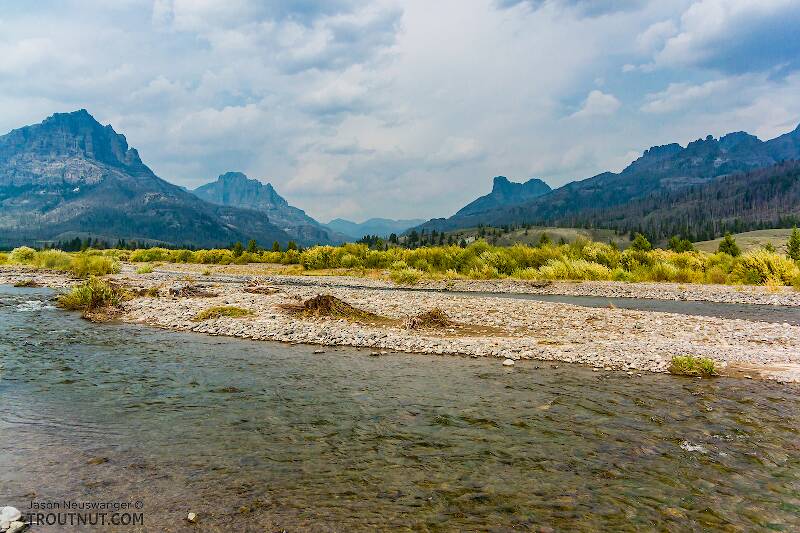
Hex Mayflies
Hexagenia limbata
The famous nocturnal Hex hatch of the Midwest (and a few other lucky locations) stirs to the surface mythically large brown trout that only touch streamers for the rest of the year.


Mayfly Species Drunella walkeri (Large Blue-Winged Olives)
An imitation is rarely required, but notes show that when it is needed it is needed badly.
See the Drunella and Drunella cornuta hatch pages for additional information.
Where & when
Conflicting accounts of the emergence dates for this species abound in literature. In Matching the Hatch, Ernest Schwiebert says they emerge in late May and early June. He was probably speaking from his knowledge of Eastern rivers. The Leonards in Mayflies of Michigan Trout Streams give emergence dates of June 26-July 24 for Michigan. This species may vary between East and Midwest like other Drunella species.In 7 records from GBIF, adults of this species have been collected during July (57%) and June (43%).
In 1 record from GBIF, this species has been collected at elevation of 1339 ft.
Species Range
Hatching behavior
Drunella walkeri emerges in the same manner as the rest of the Drunella genus.Spinner behavior
The spinner falls of this species are probably unimportant.Nymph biology
The nymphs are at home in fast riffles and slow backwaters alike. They are the closest in appearance to their large Western siblings the Western Green Drakes. Their stout bodies are easily distinguishable from other Eastern members of this genus.Identification
To determine whether a specimen of Drunella belongs to Drunella walkeri, use the Key to Species of Drunella Nymphs.
Physical description
Most physical descriptions on Troutnut are direct or slightly edited quotes from the original scientific sources describing or updating the species, although there may be errors in copying them to this website. Such descriptions aren't always definitive, because species often turn out to be more variable than the original describers observed. In some cases, only a single specimen was described! However, they are useful starting points.
Male Spinner
Wing length: 8 mm
A blackish, yellow-legged species; imago very similar to E. tuberculata (now a synonym for Drunella tuberculata), but smaller, more slender, with fewer dark femoral dots, and no ventral dark dots.
Head and thorax deep blackish brown. Fore femur and tibia deep brown; tarsus deep amber brown. Middle and hind legs yellowish, the femora heavily shaded with ruddy brown. All femora sprinkled rather sparsely with black dots. Wings hyaline; venation pale yellowish. Abdomen deep smoky brown; middle segments semi-translucent, apical segments opaque, deeper brown. Basal and middle sternites somewhat paler than the tergites; dark triangles in the antero-lateral angles, but no curved row of dark dots. Tergites rather unicolorous, but somewhat paler laterally. Tails yellowish, joinings unmarked. Genitalia very similar to E. tuberculata (now a synonym of Drunella tuberculata) (see fig. 153).
Nymph
Nymph very close to E. wayah (now a synonym of Drunella walkeri), but distinguished by the presence of a lateral prothoracic tubercle, wider femora and shorter dorsal spines.
Head of nymph with broad frontal shelf, notched on each side to receive the bases of the antennae (see fig. 151 c). No occipital tubercles; head somewhat roughened. A single small prothoracic tubercle on each side near the middle of the lateral margin. Anterior margin of fore femur with spines. All femora very much flattened, the posterior margin with a wide backward extension. Head, legs and body very hairy. Dorsal spines very minute. Ventral surface of abdomen rather less hairy than in E. wayah; no adhesive disc. General color pale greyish to deep olive brown; thorax, tibiae and tarsi with suffused darker markings. Usually a mid-dorsal row of dark blotches on the abdomen; ventrally, a lateral row of dark streaks on each side, but no curved row of dark dots between, as in E. tuberculata (now a synonym of Drunella tuberculata). Tails short, pale.
Described as E. wayah
Body length 6-7 mm
A member of the fuscata group (now a synonym of Drunella walkeri), and closely related to E. fuscata (now a synonym of Drunella walkeri). Distinguished from this species in the nymphal stage by the lack of prothoracic tubercles, better developed abdominal spines, slightly narrower femora, and somewhat longer tibial thumb. Head of nymph (see fig. 158 a) with a broad frontal shelf, widely notched on each side to receive the bases of the antennae. Frontal horns barely indicated. No occipital tubercles. All femora much flattened, but without the wide prominent posterior extension of E. fuscata; fore femur with spines on the anterior margin. Tibial spine almost one-third as long as the tarsus; blunt, stout, better developed than in fuscata (see fig. 159). Legs and entire body very hairy. No prothoracic tubercles, as in fuscata. Dorsal spines present,—not conspicuous, but better developed than in fuscata. Sternite 9 and the lateral margins of 3-8, very hairy, forming a very incomplete adhesive disc. General color (in life) grey-green; yellowish brown in alcohol. Marked irregularly with dark brown on legs, head, thorax and abdomen; tergites 8-10 usually yellowish. Abdominal sternites yellow; a lateral row of dark marks on each side, much as in E. serrata (now a synonym of Serratella serrata).
Start a Discussion of Drunella walkeri
References
- Arbona, Fred Jr. 1989. Mayflies, the Angler, and the Trout. Nick Lyons Books.
- Knopp, Malcolm and Robert Cormier. 1997. Mayflies: An Angler's Study of Trout Water Ephemeroptera . The Lyons Press.
- Leonard, Justin W. and Fannie A. Leonard. 1962. Mayflies of Michigan Trout Streams. Cranbrook Institute of Science.
- Needham, James G., Jay R. Traver, and Yin-Chi Hsu. 1935. The Biology of Mayflies. Comstock Publishing Company, Inc.
- Schwiebert, Ernest G. 1955. Matching the Hatch. MacMillan Publishing Company.
Mayfly Species Drunella walkeri (Large Blue-Winged Olives)
Species Range
Common Names
Resources
- NatureServe
- Integrated Taxonomic Information System
- Global Biodiversity Information Facility
- Described by Eaton (1884)

